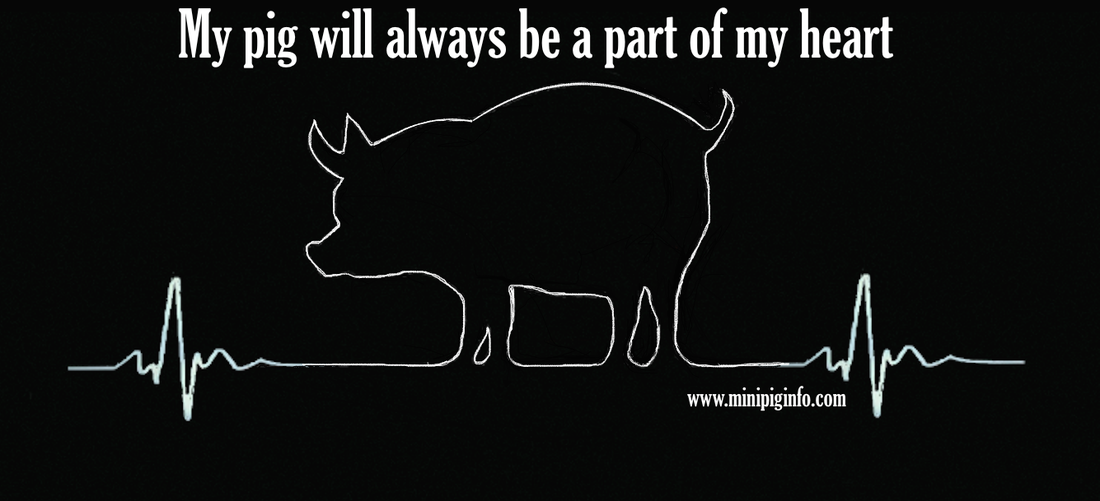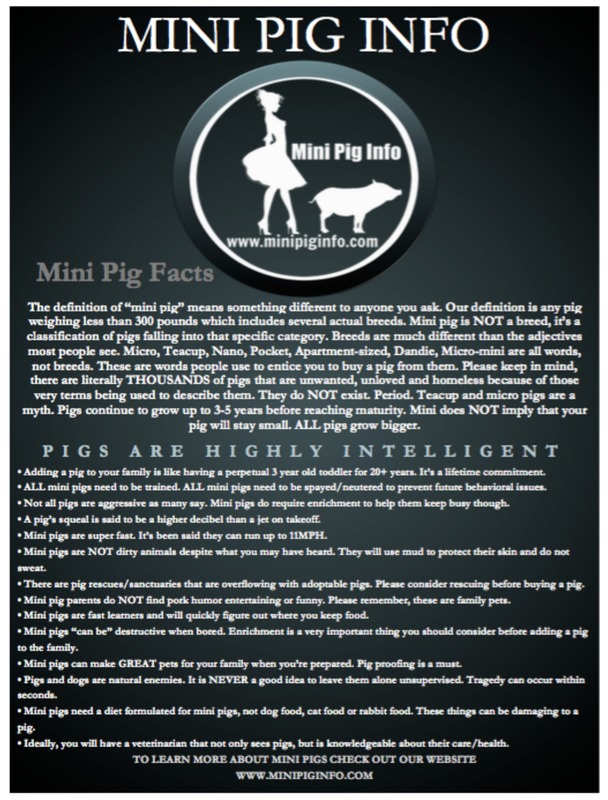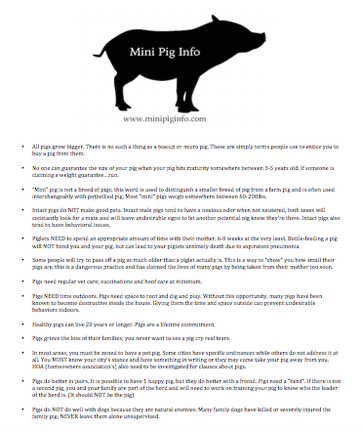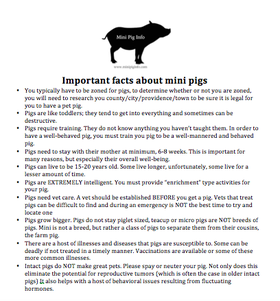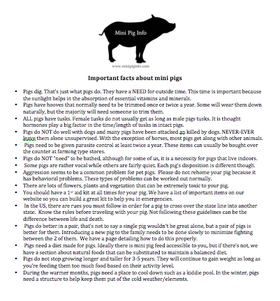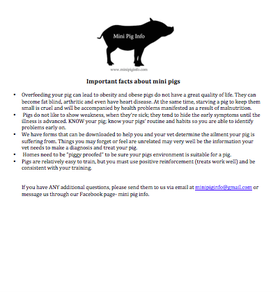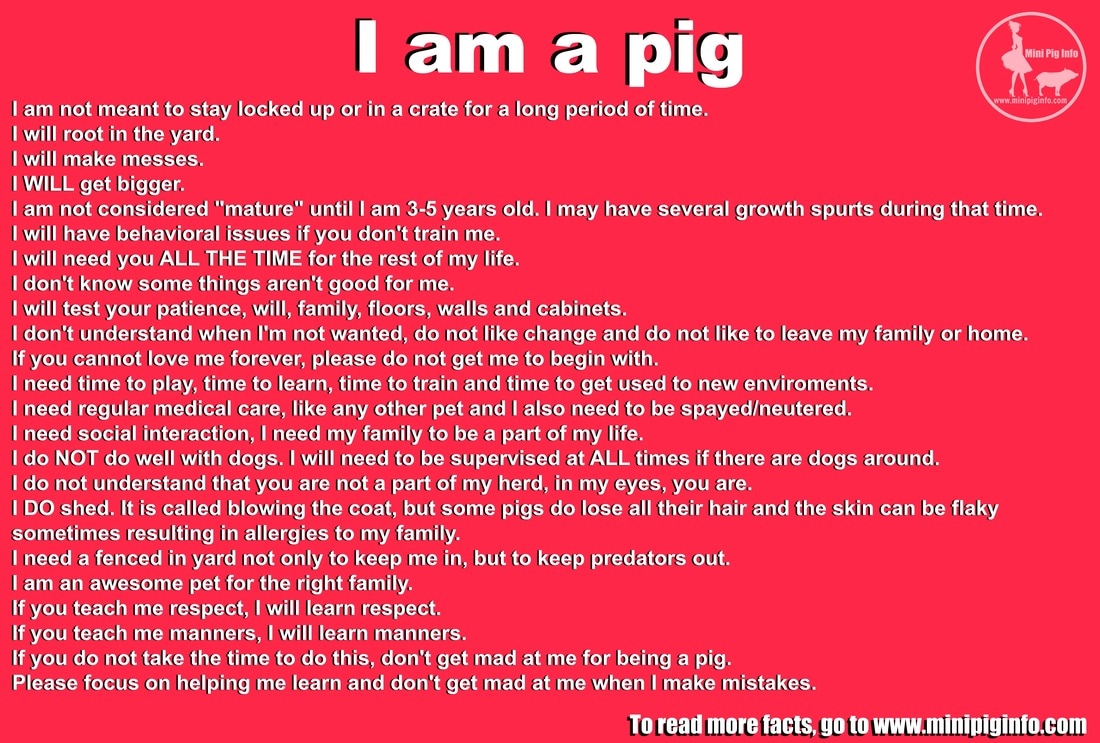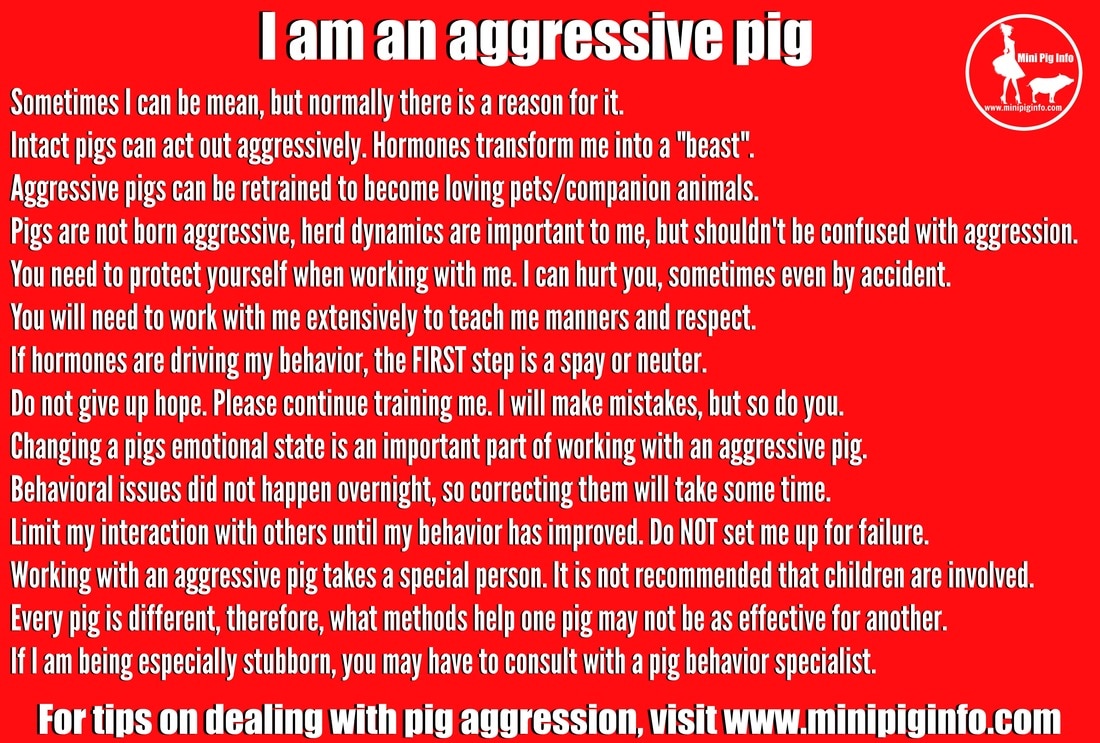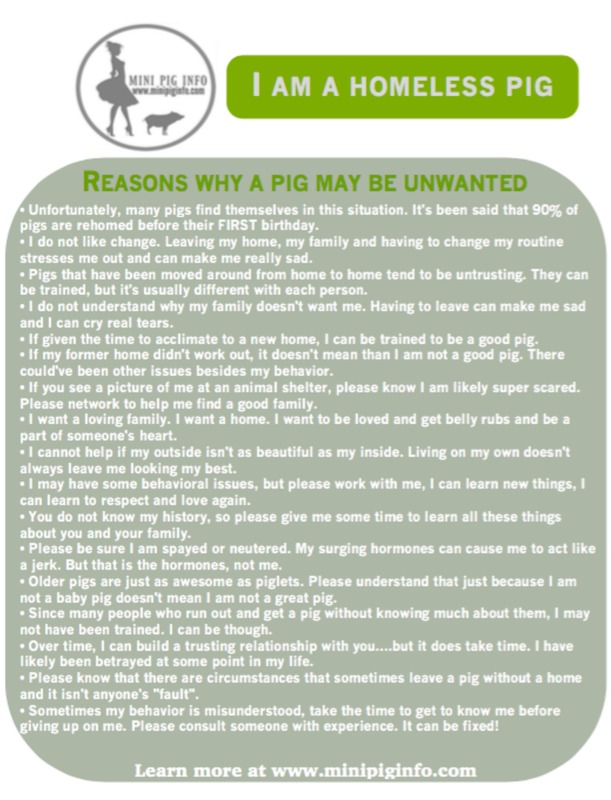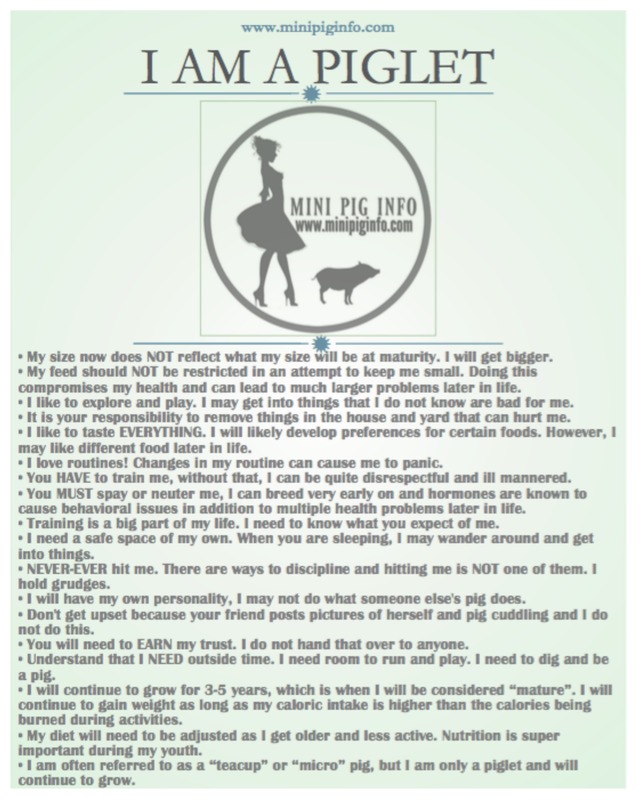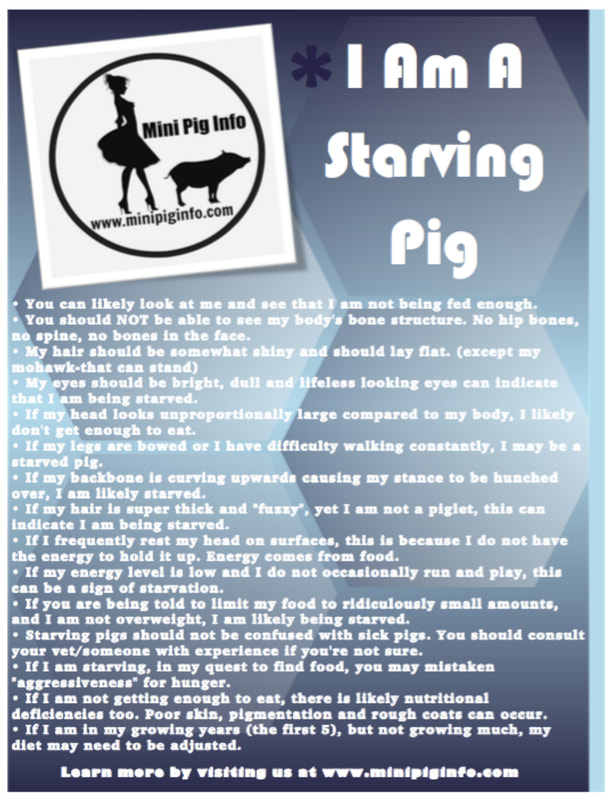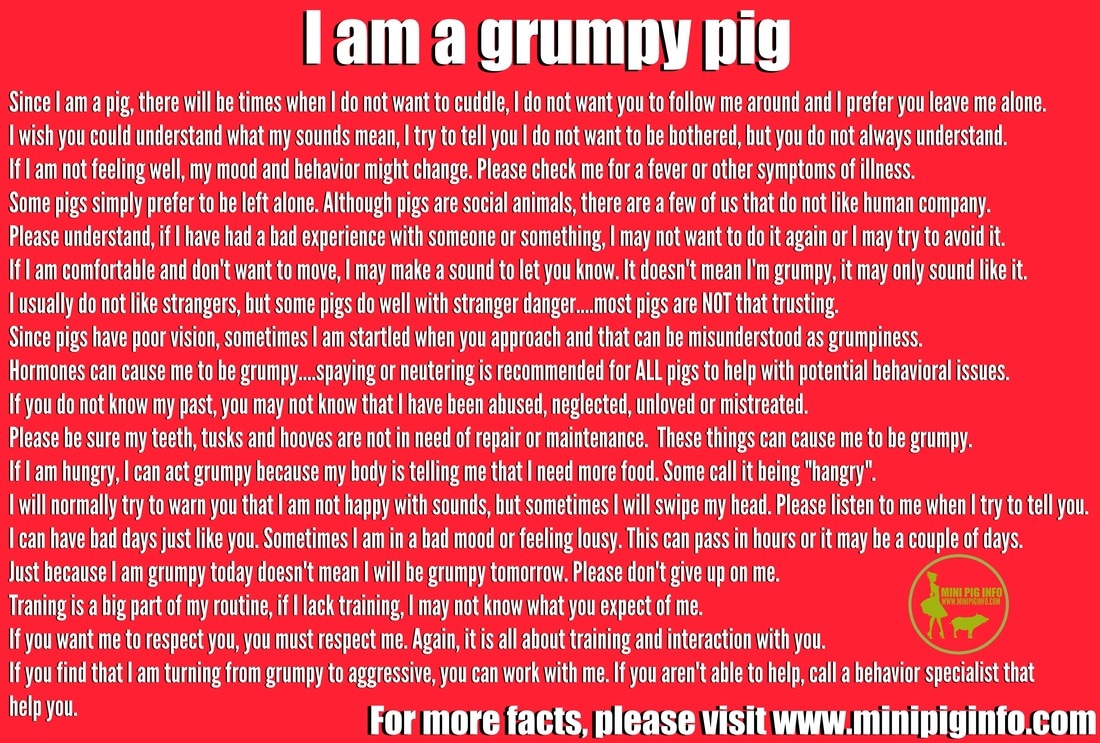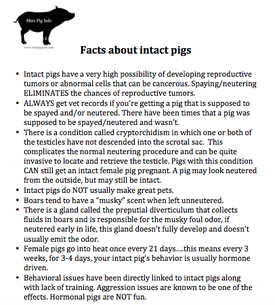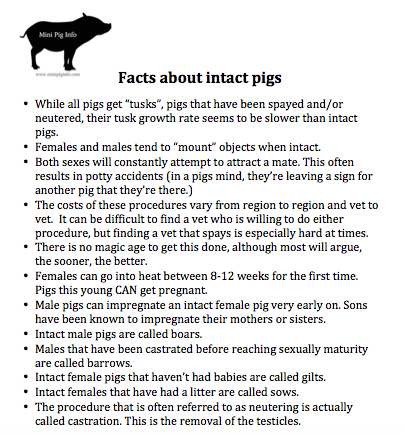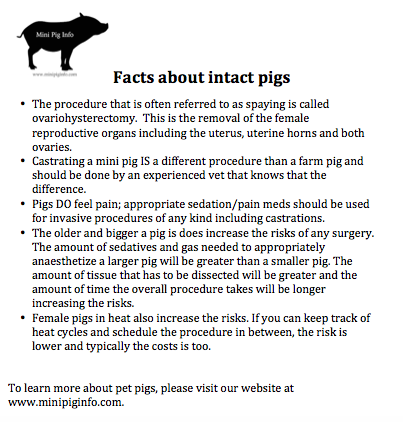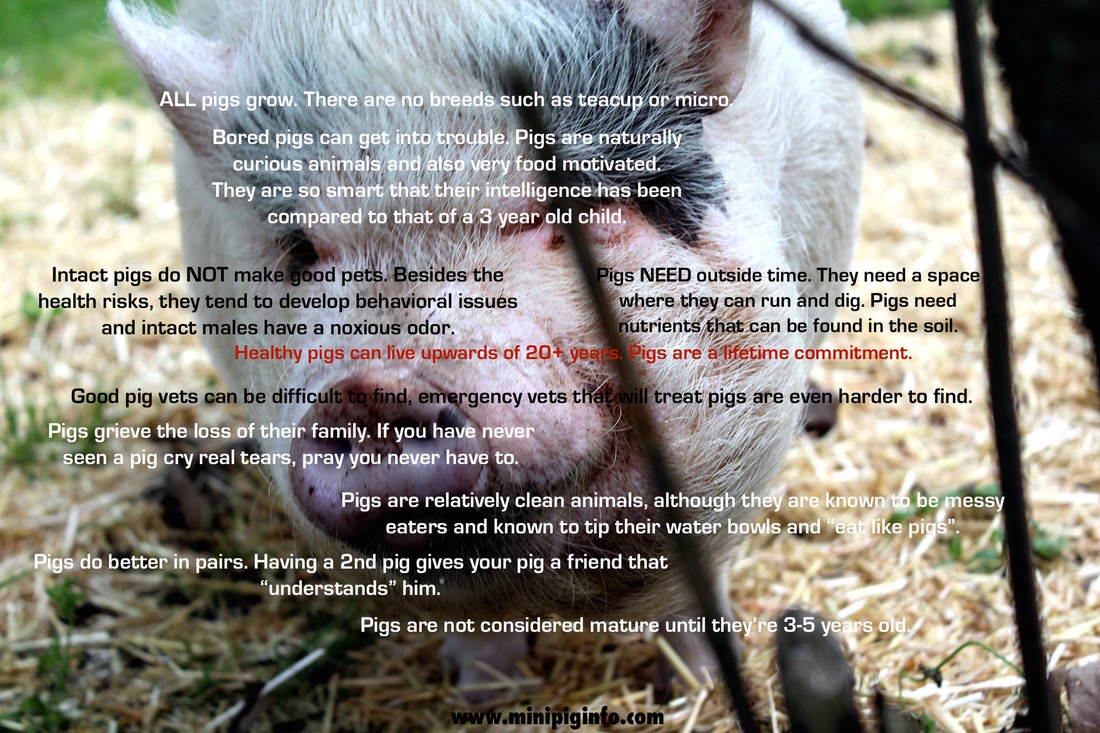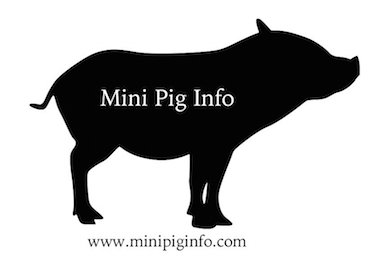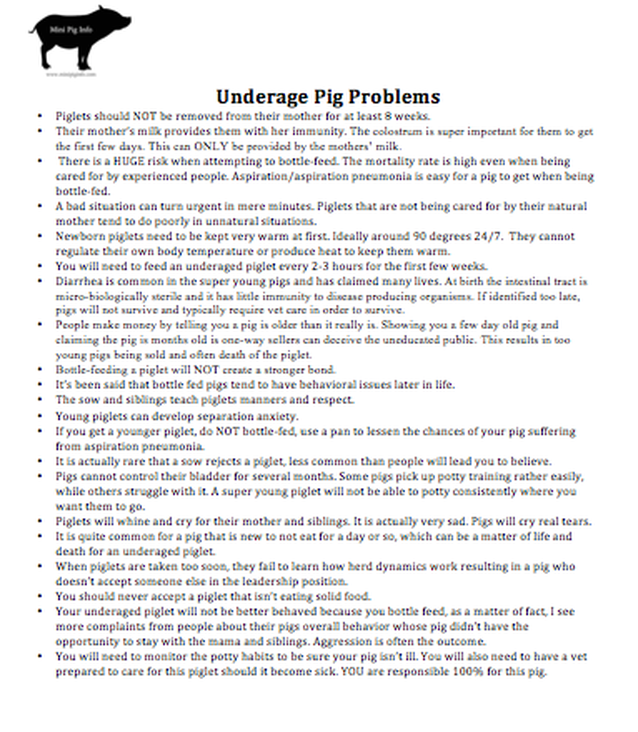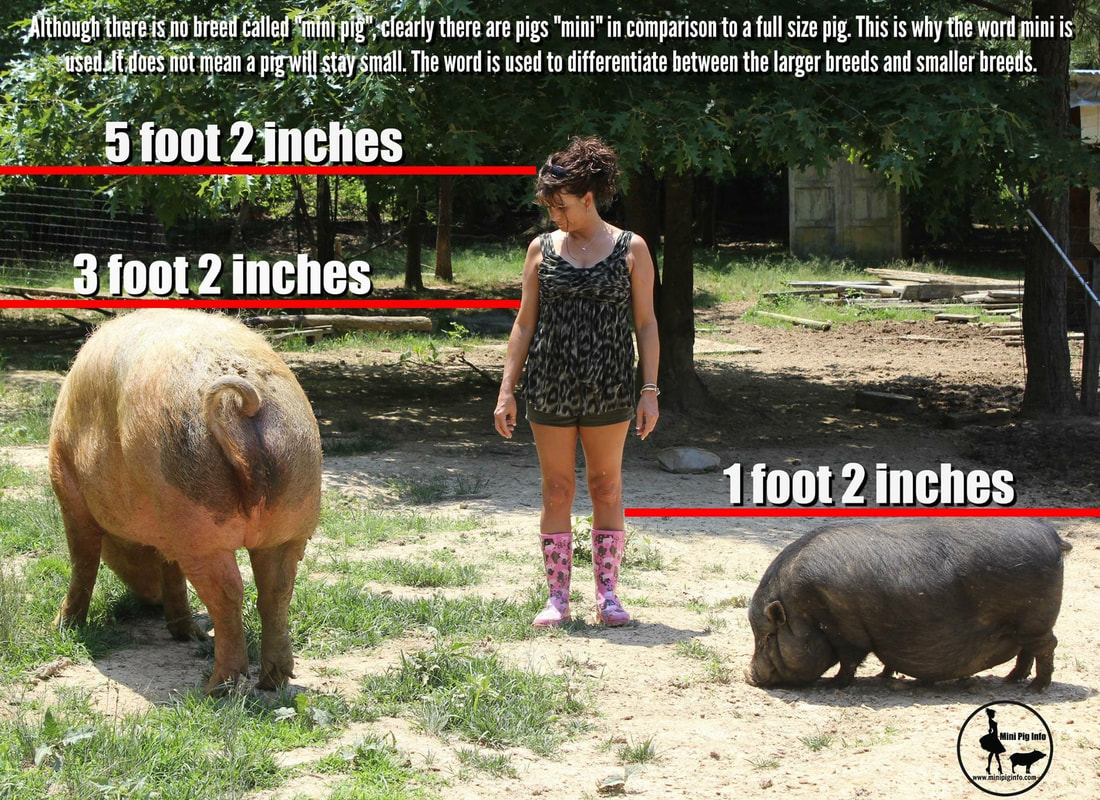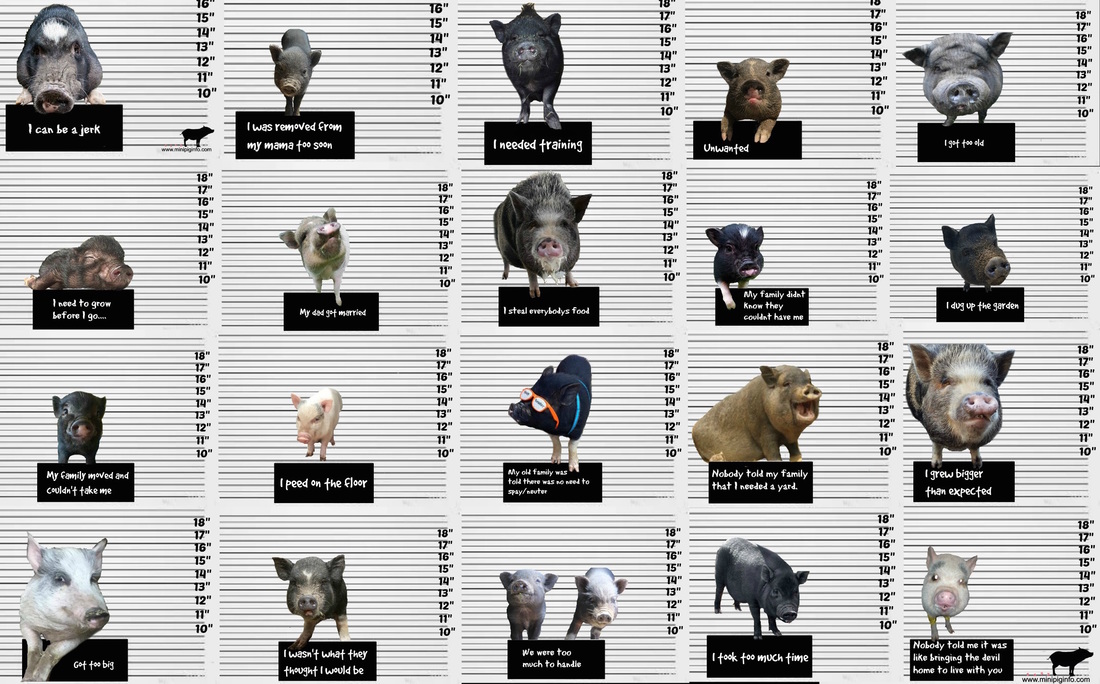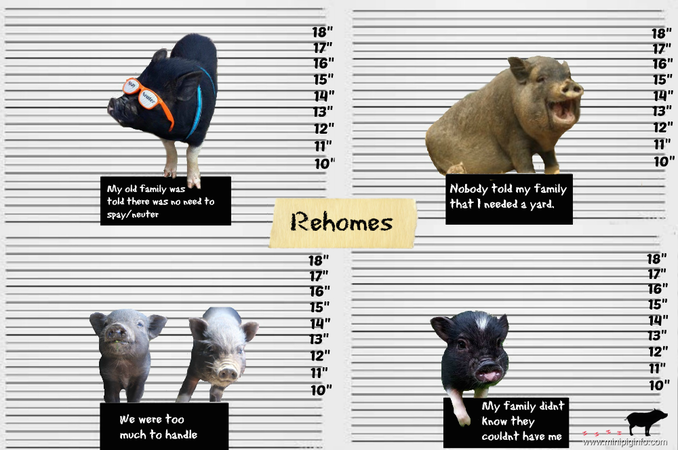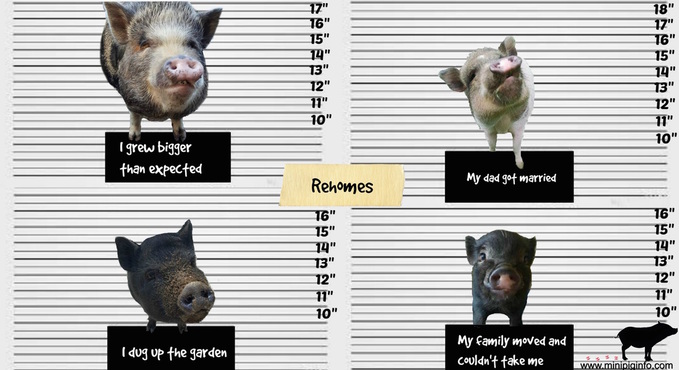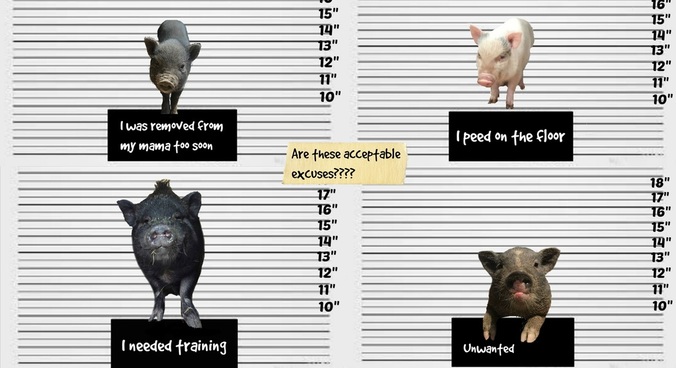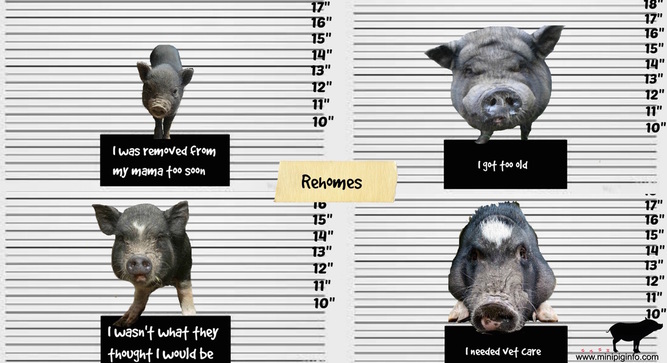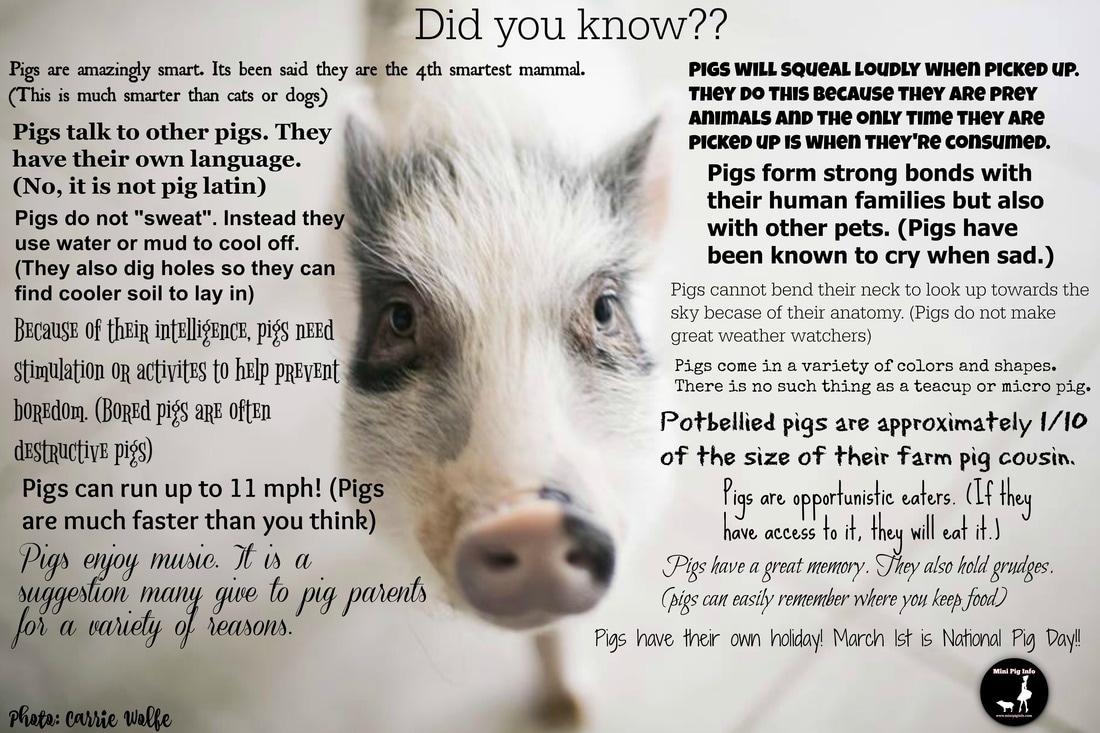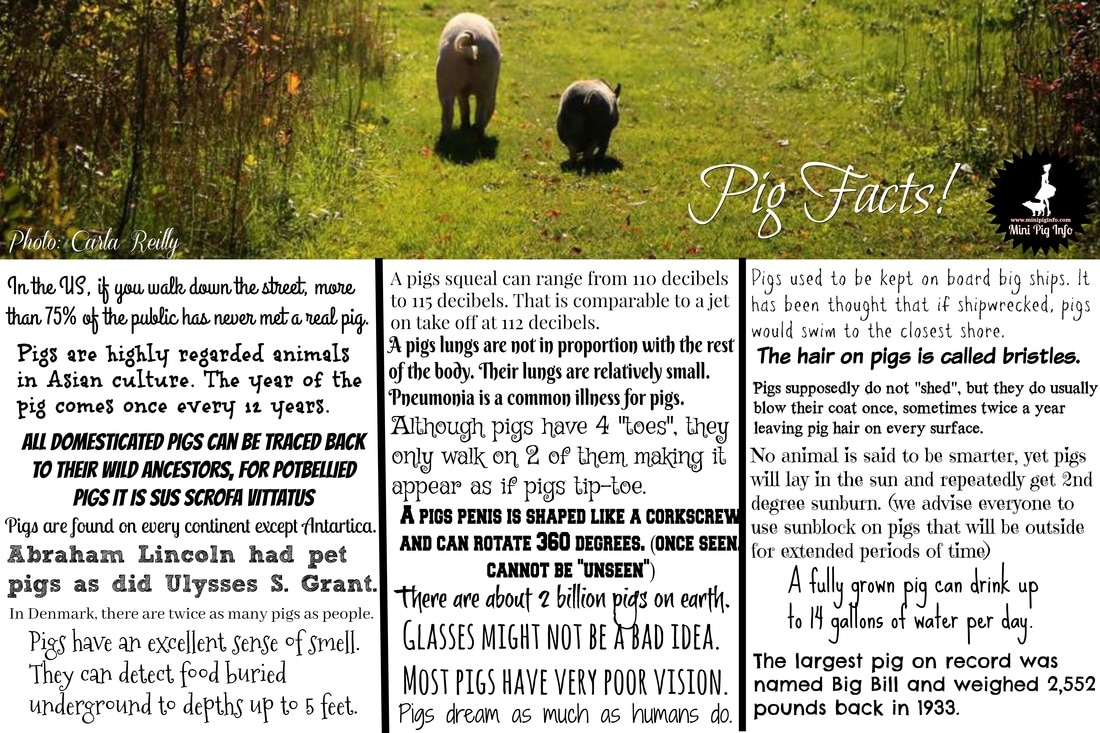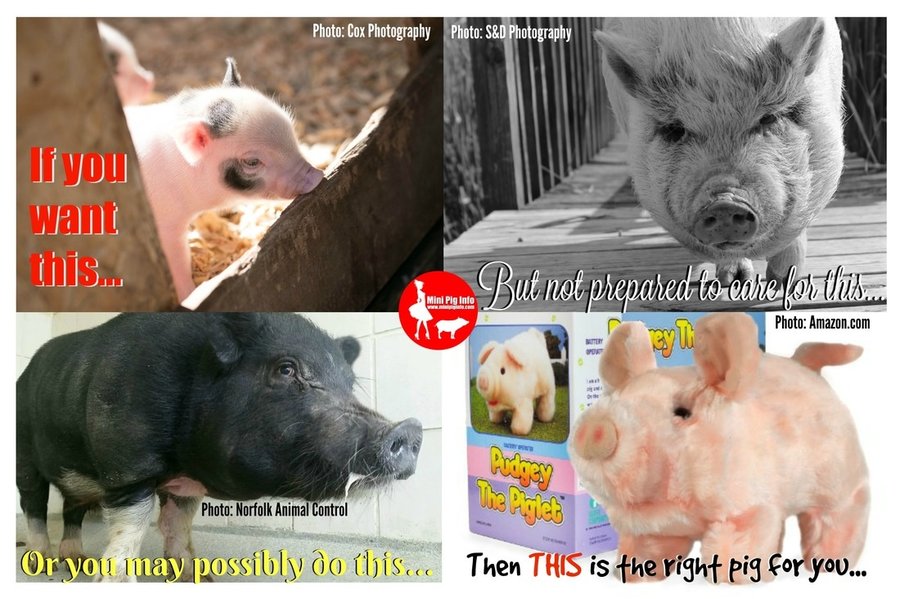Downloadable information you can print off and use for educational purposes
Important facts about mini pigs as pets. This section is being built currently, there are MANY more downloadable forms to come! Please check back soon for the updated versions. Check out our new Mini Pig Info Store for additional "swine swag" as well by clicking here.
Above is a poster that can be printed off to educate people about pigs. Feel free to download or add to your "cart" (for free) in our Mini Pig Info storefront and print off for yourself or an event you may be attending.
| mini_pig_info_facts.pdf |
Shelter Guide
This is our shelter guide, please email a copy to any animal shelters who may have a pig that has arrived. These are basic facts and a crash course, of sorts, to help anyone who isn't familiar with pigs to be able to care for them properly. Feel free to download the file or add to your cart, for free, in our store.
| mini_pig_info_shelter_guide.pdf |
| pig_fact_handout.docx |
| facts about pigs handout.pdf |
| important_facts_about_mini_pigs.docx |
| |||
| i_am_a_piglet.pdf |
| |||
Facts about intact pigs including a printable document that can be used for educational purposes.
| facts_about_intact_pigs.docx |
Facts about pigs
- All pigs grow bigger. There is no such a thing as a teacup or micro pig. These are simply terms people use to entice you to buy a pig from them.
- No one can guarantee the size of your pig when your pig hits maturity somewhere between 3-5 years old. If someone is claiming a weight guarantee…run.
- “Mini” pig is not a breed of pigs; this word is used to distinguish a smaller breed of pig from a farm pig and is often used interchangeably with potbellied pig. Most “mini” pigs weigh somewhere between 60-200lbs.
- Intact pigs do NOT make good pets. Intact male pigs tend to have a noxious odor when not neutered, both sexes will constantly look for a mate and will leave undesirable signs to let another potential pig know they’re there. Intact pigs also tend to have behavioral issues. Please spay or neuter your pig. Not only does this eliminate the potential for reproductive tumors (which is often the case in older intact pigs)By spaying/neutering, it also helps with a host of behavioral issues resulting from fluctuating hormones.
- Piglets NEED to spend an appropriate amount of time with their mother. 6-8 weeks at the very least. Bottle-feeding a pig will NOT bond you and your pig, but can lead to your piglets untimely death due to aspiration pneumonia.
- Some people will try to pass off a pig as much older than a piglet actually is. This is a way to “show” you how small their pigs are, this is a dangerous practice and has claimed the lives of many pigs by being taken from their mother too soon.
- Pigs need regular vet care; vaccinations and hoof care at minimum.
- Pigs NEED time outdoors. Pigs need space to root and dig and play. Without this opportunity, many pigs have been known to become destructive inside the house. Giving them the time and space outside can prevent undesirable behaviors indoors.
- Healthy pigs can live 20 years or longer. Pigs are a lifetime commitment.
- Pigs grieve the loss of their families; you never want to see a pig cry real tears.
- Pigs do better in pairs. It is possible to have 1 happy pig, but they do better with a friend. Pigs need a “herd”. If there is not a second pig, you and your family are part of the herd and will need to work on training your pig to know who the leader of the herd is. (It should NOT be the pig)
- Pigs do NOT do well with dogs because they are natural enemies. Many family dogs have killed or severely injured the family pig. NEVER leave them alone unsupervised. With the exception of horses, most pigs get along with other animals. However, every pig has a different disposition and not all pigs get along with every animal. Pay close attention to your pets when introducing them to your pig and be sure there are no fights that erupt between them.
- In most areas, you must be zoned to have a pet pig. Some cities have specific ordinances while others do not address it at all. You MUST know your city’s stance and have something in writing or they may come take your pig away from you. HOA (homeowners association’s) also need to be investigated for clauses about pigs.
- Pigs are like toddlers; they tend to get into everything and sometimes this can be harmful to them.
- Pigs require training. They do not know anything you haven’t taught them. In order to have a well-behaved pig, you must train you pig to be a well-mannered and behaved pig.
- Pigs are EXTREMELY intelligent. You must provide “enrichment” type activities for your pig.
- Pigs need vet care. A vet should be established BEFORE you get a pig. Vets that treat pigs can be difficult to find and during an emergency is NOT the best time to try and locate one. A good pig vet is hard to find, an emergency vet that will treat pigs is even harder to find. Have a plan in place BEFORE an emergency.
- There are a host of illnesses and diseases that pigs are susceptible to. Some can be deadly if not treated in a timely manner. Vaccinations are available for some of these more common illnesses.
- Pigs dig. That’s just what pigs do. They have a NEED for outside time. This time is important because the sunlight helps in the absorption of essential vitamins and minerals.
- Pigs have hooves that normally need to be trimmed once or twice a year. Some will wear them down naturally, but the majority will need someone to trim them.
- ALL pigs have tusks. Female tusks do not usually get as long as male pigs tusks. It is thought hormones play a big factor in the time/length of tusks in intact pigs.
- Pigs need to be given parasite control at least twice a year. These items can usually be bought over the counter at farming type stores.
- Pigs do NOT “need” to be bathed, although for some of us, it is a necessity for pigs that live indoors.
- Most pigs will blow their coat one a year leaving them bald, some do this twice a year.
- Some pigs are rather vocal while others are fairly quiet. Each pig’s disposition is different though.
- Aggression seems to be a common problem for pet pigs. Please do not rehome your pig because it has behavioral problems. These types of problems can be worked out with the right guidance.
- There are lots of flowers, plants and vegetation that can be extremely toxic to your pig.
- You should have a 1st aid kit at all times for your pig. We have a list of important items on our website so you can build a great kit to help you in emergencies.
- In the US, there are rues you must follow in order for a pig to cross over the state line into another state. Know the rules before traveling with your pig. Not following these guidelines can be the difference between life and death.
- Pigs do better in a pair, that’s not to say a single pig wouldn’t be great alone, but a pair of pigs is better for them. Introducing a new pig to the family needs to be done slowly to minimize fighting between the 2 of them. We have a page detailing how to do this properly.
- Pigs need a diet made for pigs. Ideally there is mini pig feed accessible to you, but if there’s not, we have a section about natural foods that can be substituted to maintain a balanced diet. Do NOT feed your pig dog food or other inappropriate foods made for other species of animals.
- Pigs do not stop growing longer and taller for 3-5 years. They will continue to gain weight as long as you’re feeding them too much food based on their activity level.
- During the warmer months, pigs need a place to cool down such as a kiddie pool. In the winter, pigs need a structure to help keep them put of the cold weather/elements.
- Overfeeding your pig can lead to obesity and obese pigs do not have a great quality of life. They can become fat blind, arthritic and even have heart disease. At the same time, starving a pig to keep them small is cruel and will be accompanied by health problems manifested as a result of malnutrition.
- Pigs do not like to show weakness, when they’re sick; they tend to hide the early symptoms until the illness is advanced. KNOW your pig; know your pigs’ routine and habits so you are able to identify problems early on.
- We have forms that can be downloaded to help you and your vet determine the ailment your pig is suffering from. Things you may forget or feel are unrelated may very well be the information your vet needs to make a diagnosis and treat your pig.
- Homes need to be “piggy proofed” to be sure your pigs environment is suitable for a pig.
- Pigs are relatively easy to train, but you must use positive reinforcement (treats work well) and be consistent with your training. Pigs are VERY food motivated.
- The more you handle a pig while it's young, the better your chances are of your pig being open to you handling it when it is much bigger and older.
- Pigs are much different than dogs and do not always learn using the same methods that are used to train dogs. Pigs have a herd mentality, they need a leader. This should be you, not your pig.
- Salt can be toxic to pigs, technically the condition is called water deprivation, but when pigs eat excessive amounts of salt and limited or no access to fresh water, they can have life threatening electrolyte imbalances, especially when they finally get access to fresh water. ALWAYS be sure your pig has water. If you think your pig has gone without water for an extended period of time, please hydrate SLOWLY!
Facts about intact pigs
- Intact pigs have a very high possibility of developing reproductive tumors or abnormal cells that can be cancerous. Spaying/neutering ELIMINATES the chances of reproductive tumors.
- ALWAYS get vet records if you’re getting a pig that is supposed to be spayed and/or neutered. There have been times that a pig was supposed to be spayed/neutered and wasn’t.
- There is a condition called cryptorchidism in which one or both of the testicles have not descended into the scrotal sac. This complicates the normal neutering procedure and can be quite invasive to locate and retrieve the testicle. Pigs with this condition CAN still get an intact female pig pregnant. A pig may look neutered from the outside, but may still be intact.
- Intact pigs do NOT usually make great pets.
- Boars tend to have a “musky” scent when left unneutered.
- There is a gland called the preputial diverticulum that collects fluids in boars and is responsible for the musky foul odor, if neutered early in life, this gland doesn’t fully develop and doesn’t usually emit the odor.
- Female pigs go into heat once every 21 days….this means every 3 weeks, for 3-4 days, your intact pig’s behavior is usually hormone driven.
- Behavioral issues have been directly linked to intact pigs along with lack of training. Aggression issues are known to be one of the effects. Hormonal pigs are NOT fun.
- While all pigs get “tusks”, pigs that have been spayed and/or neutered, their tusk growth rate seems to be slower than intact pigs.
- Females and males tend to “mount” objects when intact.
- Both sexes will constantly attempt to attract a mate. This often results in potty accidents (in a pigs mind, they’re leaving a sign for another pig that they’re there.)
- The costs of these procedures vary from region to region and vet to vet. It can be difficult to find a vet who is willing to do either procedure, but finding a vet that spays is especially hard at times.
- There is no magic age to get this done, although most will argue, the sooner, the better.
- Females can go into heat between 8-12 weeks for the first time. Pigs this young CAN get pregnant.
- Male pigs can impregnate an intact female pig very early on. Sons have been known to impregnate their mothers or sisters.
- Intact male pigs are called boars.
- Males that have been castrated before reaching sexually maturity are called barrows.
- Intact female pigs that haven’t had babies are called gilts.
- Intact females that have had a litter are called sows.
- The procedure that is often referred to as neutering is actually called castration. This is the removal of the testicles.
- The procedure that is often referred to as spaying is called ovariohysterectomy. This is the removal of the female reproductive organs including the uterus, uterine horns and both ovaries.
- Castrating a mini pig IS a different procedure than a farm pig and should be done by an experienced vet that knows that the difference.
- Pigs DO feel pain; appropriate sedation/pain meds should be used for invasive procedures of any kind including castrations.
- The older and bigger a pig is does increase the risks of any surgery. The amount of sedatives and gas needed to appropriately anaesthetize a larger pig will be greater than a smaller pig. The amount of tissue that has to be dissected will be greater and the amount of time the overall procedure takes will be longer increasing the risks.
- Female pigs in heat also increase the risks. If you can keep track of heat cycles and schedule the procedure in between, the risk is lower and typically the costs is too.
Underage pig facts/problems
| underage_pig_problems.docx |
What is a "mini pig"?
Most common reasons why pigs need to be rehomed....
Rachel the Piggy Bank @ Pike Place Market
They say pigs leave hoof prints on our hearts and in our lives, well in Seattle Washington, hoof prints do more than just touch our hearts. To Rachel and Billie, the Pigs do more than just touch pig lovers hearts. They help the low income Market Clinic, Senior Center, Food Bank, and Preschool of Pike Place Market.
Rachel was established in 1986, in the Pike Place Market in downtown Seattle Washington. She weighs approximately 550 pounds and was named after a real 750 pound pig that won the 1985 Island County Fair. In 2011 Billie was added to the bottom of the Hillclimb on Western Ave. Since 1986 over $200,000 has been donated through Rachel and Billie and has even been the inspiration for the "Pigs on Parade" fundraisers!
One of the coolest parts is you can buy a hoof print for a small donation of $5,000 that is forever laid in the cement near Rachel in Pike Place Market. Now while I couldn't afford a hoof print, I did make a donation to Rachel, take multiple selfies with both her and Billie, and collected a souvenir stamped penny in her honor. Legend has it that if you rub Rachel’s snout and make a donation, you’ll have good luck! Seeing Rachel and Billie was the highlight of my trip and yes I did rub her belly and kissed her snout!
http://pikeplacemarket.org/rachel-piggy-bank
Rachel was established in 1986, in the Pike Place Market in downtown Seattle Washington. She weighs approximately 550 pounds and was named after a real 750 pound pig that won the 1985 Island County Fair. In 2011 Billie was added to the bottom of the Hillclimb on Western Ave. Since 1986 over $200,000 has been donated through Rachel and Billie and has even been the inspiration for the "Pigs on Parade" fundraisers!
One of the coolest parts is you can buy a hoof print for a small donation of $5,000 that is forever laid in the cement near Rachel in Pike Place Market. Now while I couldn't afford a hoof print, I did make a donation to Rachel, take multiple selfies with both her and Billie, and collected a souvenir stamped penny in her honor. Legend has it that if you rub Rachel’s snout and make a donation, you’ll have good luck! Seeing Rachel and Billie was the highlight of my trip and yes I did rub her belly and kissed her snout!
http://pikeplacemarket.org/rachel-piggy-bank

